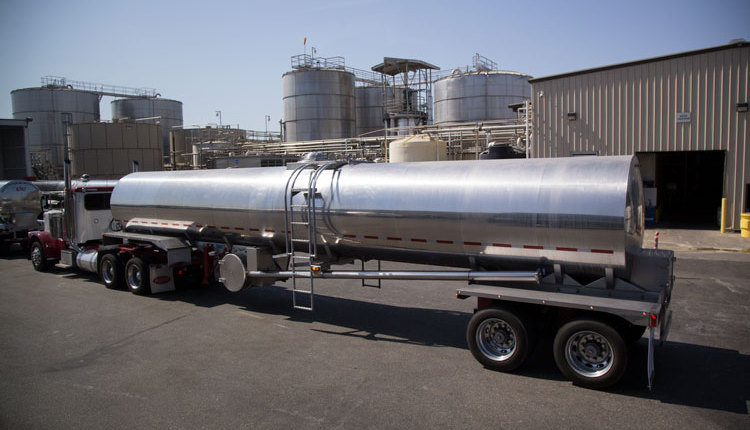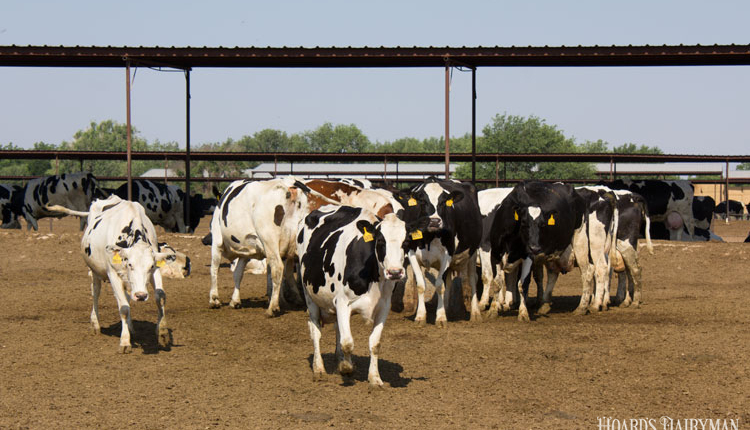The author is a professor and extension dairy specialist with Texas AgriLife Extension Service, Texas A&M University system.
This past summer researchers from around the world met in Montreal, Quebec, Canada at the joint annual meeting of the American Dairy Science Association (ADSA), the American Society of Animal Science, and the Canadian Society of Animal Science. During the meeting, a total of 810 oral presentations and 1,086 posters were on display for an "early look" at future dairy research that will be reported in technical journals and conferences in the next two years.
For dairy managers and consultants that have internet access, it would be beneficial to become a member of ADSA which allows you to access the monthly electronic Journal of Dairy Science and Scientific Proceedings of Animal Conferences or S-PAC (34 conferences with 279 proceedings are available online with key word searches by author or topic area). Contact ADSA at adsa@adsa.org on how to join.
The following are summaries of some of the abstracts presented on dairy reproduction along with comments and a contact author for additional information.When a P<0.01 is reported, it means that 99 percent of the time the same results would be expected if the research was repeated. Because of the large number of cows required for reproductive research, some studies with a tendency (P<0.10) are reported. That means that 10 percent of the time when these studies are repeated different results will be obtained.
Resynchronization strategies
Presynchronization has been coupled with estrous synchronization programs to boost the number of cows becoming pregnant at first insemination by increasing the number of cows in the correct phase of the estrous cycle. Pregnancy results from resynchronization after nonpregnancy diagnosis have not met expectations, possibly as a result of the variability in the stage of the estrous cycle.
In an attempt to identify a resynchronization strategy to improve fertility without elevating the time to subsequent insemination, cows in two herds in Arizona and California were assigned to one of three treatment protocols. At 32 days postinsemination cows were randomly assigned to the resynchronization protocols. All cows went through a nonpregnancy diagnosis at approximately 39 days postinsemination. The resynchronization protocols were:
1. Control (n=386) - At nonpregnancy diagnosis on Day 39, cows were given the first GnRH of a Cosynch-72 protocol. They received prostaglandin seven days later and were bred and given a second dose of GnRH three days later.
2. GGPG (n=357) - On Day 32 postinsemination, these cows were given GnRH. At nonpregnancy diagnosis on Day 39, they received the same Cosynch-72 protocol as the control groups.
3. CIDR (n=316) - The nonpregnant animals in this group also began the Cosynch-72 protocol on Day 39. In addition, a CIDR was inserted at the time GnRH was given. The CIDR was removed seven days later, at the same time of the prostaglandin injection.
More cows were pregnant in both the GGPG (33.6 percent) and CIDR (31.3 percent) groups than in the control (24.6 percent) at the nonpregnancy diagnosis approximately 39 days postinsemination. There was an interaction with body condition score. More thin cows (BCS?2.75) became pregnant in the CIDR group, while more moderately conditioned cows (BCS>2.75) became pregnant with the GGPG treatment.
Comment: Results from this study indicate that the number of cows becoming pregnant after a nonpregnancy diagnosis can be improved either by adding an injection of GnRH seven days prior to the nonpregnancy diagnosis or by adding a CIDR into the Cosynch-72 program. The success varies with the body condition of the cows.
Contact: Todd Bilby, Texas A&M AgriLife Research and Extension; phone: (254) 968-4144; e-mail: trbilby@ag.tamu.edu
Economics of resynchronization
The three resynchronization protocols described in the preceding research were evaluated to determine if the extra cost associated with GGPG and the CIDR were economically beneficial. The average costs used were: prostaglandins, $1.50; labor, $10 per hour; GnRH, $1.50; CIDR, $10 each; and pregnancy value, $275. The average cost for the control, GGPG, and CIDR treatments were $5.40, $10.66, and $14.85, with an average return per cow of $55.04, $73.29, and $60.64.
For the average costs, these returns were not significantly different (P=0.17). However, when 81 different scenarios were developed by varying the cost of the GnRH (range: $1-$5), CIDR (range: $5-$15), and pregnancy value (range: $100-$500); the average return was greatest for the GGPG protocol ($36.40), intermediary for the CIDR treatment ($33.25), and lowest for the control group ($27.50).
Comment: The economic evaluation indicates that adding either an extra GnRH injection (GGPG group) or CIDR insert (CIDR group) to CoSynch-72 raised the return per cow when resynchronizing nonpregnant cows.
Contact: Ricardo Chebel, University of Minnesota; phone: (612) 625-3130; e-mail: chebe002@umn.edu
Double Ovsynch for resynchronization
In this trial, resynchronization was accomplished by using either a Double Ovsynch protocol or an Ovsynch protocol. The cows were randomly assigned to two groups and received varying treatments relative to the previous artificial insemination date. The groups were synchronized as follows based on the days from initial insemination:
• Double Ovsynch (n=962): d22 (Day 22), GnRH; d29, ultrasound and nonpregnant animals given prostaglandin; d32, GnRH; d39 GnRH (begin Ovsynch-56); d46, prostaglandin; 56 hours later GnRH; and rebred 16 hours later.
• Ovsynch (n=956): d32 GnRH (begin Ovsynch-56); d39, palpation and prostaglandin for nonpregnant cows; 56 hours later GnRH; and rebred 16 hours later.
All cows in both groups were then ultrasounded 29 days postinsemination to determine pregnancy status, and 74 days after insemination they were palpated to reconfirm pregnancy. More cows receiving the Double Ovsynch protocol (38.5 percent) conceived to the resynch insemination than those treated with Ovsynch-56 (30.0 percent). Pregnancy loss between the ultrasound at Day 29 and palpation at Day 74 did not differ between the Double Ovsynch (13.9 percent) and Ovsynch-56 (17.5 percent) treatment groups.
Comment: Using a Double Ovsynch protocol improved the percentage of cows becoming pregnant after a resynchronized insemination; however, it required an additional seven days and three hormonal injections compared to the Ovsynch-56 treatment.
Contact: Paul Fricke, University of Wisconsin; phone: (608) 263-9412; e-mail: pmfricke@wisc.edu
Click here to return to the Reproduction E-Sources
100225_133
This past summer researchers from around the world met in Montreal, Quebec, Canada at the joint annual meeting of the American Dairy Science Association (ADSA), the American Society of Animal Science, and the Canadian Society of Animal Science. During the meeting, a total of 810 oral presentations and 1,086 posters were on display for an "early look" at future dairy research that will be reported in technical journals and conferences in the next two years.
For dairy managers and consultants that have internet access, it would be beneficial to become a member of ADSA which allows you to access the monthly electronic Journal of Dairy Science and Scientific Proceedings of Animal Conferences or S-PAC (34 conferences with 279 proceedings are available online with key word searches by author or topic area). Contact ADSA at adsa@adsa.org on how to join.
The following are summaries of some of the abstracts presented on dairy reproduction along with comments and a contact author for additional information.When a P<0.01 is reported, it means that 99 percent of the time the same results would be expected if the research was repeated. Because of the large number of cows required for reproductive research, some studies with a tendency (P<0.10) are reported. That means that 10 percent of the time when these studies are repeated different results will be obtained.
Resynchronization strategies
Presynchronization has been coupled with estrous synchronization programs to boost the number of cows becoming pregnant at first insemination by increasing the number of cows in the correct phase of the estrous cycle. Pregnancy results from resynchronization after nonpregnancy diagnosis have not met expectations, possibly as a result of the variability in the stage of the estrous cycle.
In an attempt to identify a resynchronization strategy to improve fertility without elevating the time to subsequent insemination, cows in two herds in Arizona and California were assigned to one of three treatment protocols. At 32 days postinsemination cows were randomly assigned to the resynchronization protocols. All cows went through a nonpregnancy diagnosis at approximately 39 days postinsemination. The resynchronization protocols were:
1. Control (n=386) - At nonpregnancy diagnosis on Day 39, cows were given the first GnRH of a Cosynch-72 protocol. They received prostaglandin seven days later and were bred and given a second dose of GnRH three days later.
2. GGPG (n=357) - On Day 32 postinsemination, these cows were given GnRH. At nonpregnancy diagnosis on Day 39, they received the same Cosynch-72 protocol as the control groups.
3. CIDR (n=316) - The nonpregnant animals in this group also began the Cosynch-72 protocol on Day 39. In addition, a CIDR was inserted at the time GnRH was given. The CIDR was removed seven days later, at the same time of the prostaglandin injection.
More cows were pregnant in both the GGPG (33.6 percent) and CIDR (31.3 percent) groups than in the control (24.6 percent) at the nonpregnancy diagnosis approximately 39 days postinsemination. There was an interaction with body condition score. More thin cows (BCS?2.75) became pregnant in the CIDR group, while more moderately conditioned cows (BCS>2.75) became pregnant with the GGPG treatment.
Comment: Results from this study indicate that the number of cows becoming pregnant after a nonpregnancy diagnosis can be improved either by adding an injection of GnRH seven days prior to the nonpregnancy diagnosis or by adding a CIDR into the Cosynch-72 program. The success varies with the body condition of the cows.
Contact: Todd Bilby, Texas A&M AgriLife Research and Extension; phone: (254) 968-4144; e-mail: trbilby@ag.tamu.edu
Economics of resynchronization
The three resynchronization protocols described in the preceding research were evaluated to determine if the extra cost associated with GGPG and the CIDR were economically beneficial. The average costs used were: prostaglandins, $1.50; labor, $10 per hour; GnRH, $1.50; CIDR, $10 each; and pregnancy value, $275. The average cost for the control, GGPG, and CIDR treatments were $5.40, $10.66, and $14.85, with an average return per cow of $55.04, $73.29, and $60.64.
For the average costs, these returns were not significantly different (P=0.17). However, when 81 different scenarios were developed by varying the cost of the GnRH (range: $1-$5), CIDR (range: $5-$15), and pregnancy value (range: $100-$500); the average return was greatest for the GGPG protocol ($36.40), intermediary for the CIDR treatment ($33.25), and lowest for the control group ($27.50).
Comment: The economic evaluation indicates that adding either an extra GnRH injection (GGPG group) or CIDR insert (CIDR group) to CoSynch-72 raised the return per cow when resynchronizing nonpregnant cows.
Contact: Ricardo Chebel, University of Minnesota; phone: (612) 625-3130; e-mail: chebe002@umn.edu
Double Ovsynch for resynchronization
In this trial, resynchronization was accomplished by using either a Double Ovsynch protocol or an Ovsynch protocol. The cows were randomly assigned to two groups and received varying treatments relative to the previous artificial insemination date. The groups were synchronized as follows based on the days from initial insemination:
• Double Ovsynch (n=962): d22 (Day 22), GnRH; d29, ultrasound and nonpregnant animals given prostaglandin; d32, GnRH; d39 GnRH (begin Ovsynch-56); d46, prostaglandin; 56 hours later GnRH; and rebred 16 hours later.
• Ovsynch (n=956): d32 GnRH (begin Ovsynch-56); d39, palpation and prostaglandin for nonpregnant cows; 56 hours later GnRH; and rebred 16 hours later.
All cows in both groups were then ultrasounded 29 days postinsemination to determine pregnancy status, and 74 days after insemination they were palpated to reconfirm pregnancy. More cows receiving the Double Ovsynch protocol (38.5 percent) conceived to the resynch insemination than those treated with Ovsynch-56 (30.0 percent). Pregnancy loss between the ultrasound at Day 29 and palpation at Day 74 did not differ between the Double Ovsynch (13.9 percent) and Ovsynch-56 (17.5 percent) treatment groups.
Comment: Using a Double Ovsynch protocol improved the percentage of cows becoming pregnant after a resynchronized insemination; however, it required an additional seven days and three hormonal injections compared to the Ovsynch-56 treatment.
Contact: Paul Fricke, University of Wisconsin; phone: (608) 263-9412; e-mail: pmfricke@wisc.edu
100225_133











